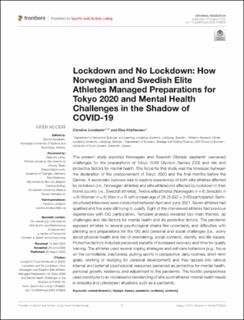| dc.contributor.author | Lundqvist, Carolina | |
| dc.contributor.author | Kristiansen, Elsa | |
| dc.date.accessioned | 2022-12-09T11:29:33Z | |
| dc.date.available | 2022-12-09T11:29:33Z | |
| dc.date.created | 2022-08-05T10:17:46Z | |
| dc.date.issued | 2022 | |
| dc.identifier.citation | Lundqvist, C. & Kristiansen, E. (2022). Lockdown and No Lockdown: How Norwegian and Swedish Elite Athletes Managed Preparations for Tokyo 2020 and Mental Health Challenges in the Shadow of COVID-19. Frontiers in Sports and Active Living, 4, Artikkel 918825. | en_US |
| dc.identifier.issn | 2624-9367 | |
| dc.identifier.uri | https://hdl.handle.net/11250/3036995 | |
| dc.description.abstract | The present study explored Norwegian and Swedish Olympic aspirants' perceived challenges for the preparations of Tokyo 2020 Olympic Games (OG) and risk and protective factors for mental health. The focus for this study was the timespan between the declaration of the postponement of Tokyo 2020 and the final months before the Games. A secondary purpose was to explore experiences of both elite athletes affected by lockdown (i.e., Norwegian athletes) and elite athletes not affected by lockdown in their home country (i.e., Swedish athletes). Twelve elite athletes (Norwegian: n = 6; Swedish: n = 6; Women: n = 6; Men: n = 6) with a mean age of 28.25 (SD = 3.60) participated. Semi-structured interviews were conducted between April and June 2021. Seven athletes had qualified and five were still trying to qualify. Eight of the interviewed athletes had previous experiences with OG participation. Template analysis revealed two main themes: (a) challenges and risk-factors for mental health and (b) protective factors. The pandemic exposed athletes to several psychological strains like uncertainty and difficulties with planning and preparations for the OG and personal and social challenges (i.e., worry about physical health and risk of overtraining, social contacts, identity, and life issues). Protective factors included perceived benefits of increased recovery and time for quality training. The athletes used several coping strategies and self-care behaviors (e.g., focus on the controllable, playfulness, putting sports in perspective, daily routines, short-term goals, working or studying for personal development) and they tapped into various internal and external psychosocial resources perceived as protective for mental health, personal growth, resiliency, and adjustment to the pandemic. The holistic perspectives used contribute to an increased understanding of elite sport athletes' mental health needs in stressful and unforeseen situations such as a pandemic. | en_US |
| dc.language.iso | eng | en_US |
| dc.rights | Navngivelse 4.0 Internasjonal | * |
| dc.rights.uri | http://creativecommons.org/licenses/by/4.0/deed.no | * |
| dc.title | Lockdown and No Lockdown: How Norwegian and Swedish Elite Athletes Managed Preparations for Tokyo 2020 and Mental Health Challenges in the Shadow of COVID-19 | en_US |
| dc.type | Journal article | en_US |
| dc.type | Peer reviewed | en_US |
| dc.description.version | publishedVersion | en_US |
| dc.rights.holder | © 2022 Lundqvist and Kristiansen. | en_US |
| dc.source.pagenumber | 12 | en_US |
| dc.source.volume | 4 | en_US |
| dc.source.journal | Frontiers in Sports and Active Living | en_US |
| dc.identifier.doi | https://doi.org/10.3389/fspor.2022.918825 | |
| dc.identifier.cristin | 2041333 | |
| dc.source.articlenumber | 918825 | en_US |
| cristin.ispublished | true | |
| cristin.fulltext | original | |
| cristin.qualitycode | 1 | |

